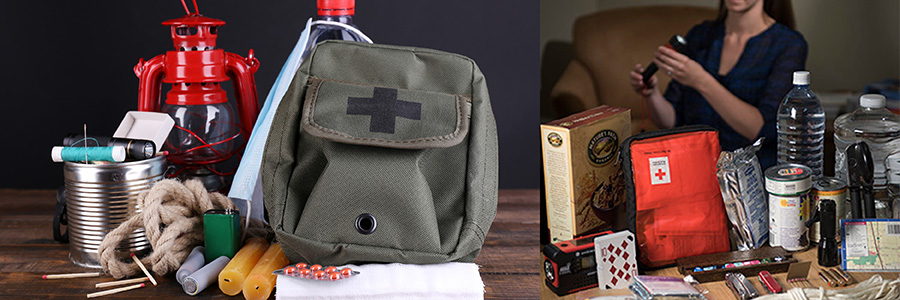Stock six basics in your home: water, food, first aid supplies, clothing and bedding, tools and special items. Keep the items you would most likely need during an evacuation in an easy-to carry container such as a large, covered trash can, camping backpack or duffle bag.
Water
- Store water in plastic containers. Avoid using containers that will decompose or break.
- Store one gallon of water per person per day. Hot environments and intense physical activity can require more. Children, nursing mothers and ill people will need more.
- Keep at least a three-day supply of water per person: two quarts for drinking, two quarts for food preparation/sanitation.
Food
- Store at least a three-day supply of non-perishable food. Select foods that require no refrigeration, preparation or cooking, and little or no water. If you must heat food, pack a can of sterno. Select food items that are compact and lightweight. Include a selection of the following foods:
- Ready-to-eat canned meats, fruits and vegetables
- Canned juices
- Staples such salt, sugar, pepper and spices
- High energy foods
- Vitamins
- Food for infants
- Comfort/stress foods
First aid kit
- Assemble a first aid kit for your home and one for each car.
- 20 adhesive bandages, various sizes
- 1 5x9 inch sterile dressing
- 1 conforming roller gauze bandage
- 2 triangular bandages
- 2 3x3 inch sterile gauze pads
- 2 4x4 inch sterile gauze pads
- 1 roll 3 inch cohesive bandage
- 2 germicidal hand wipes or waterless alcohol-based hand sanitizer
- 6 antiseptic wipes
- 2 pair large medical grade, non-latex gloves
- Adhesive tape, 2 inch width
- Anti-bacterial ointment
- Cold pack
- Scissors (small, personal)
- Tweezers
- CPR breathing barrier, such as a face shield
Non-prescription drugs
- Aspirin or non-aspirin pain reliever
- Anti-diarrhea medication
- Antacid for stomach upset
- Laxative
- Activated charcoal, to use if advised by the Poison Control Center
Tools and supplies
- Mess kits or paper cups, plates and plastic utensils
- Emergency preparedness manual
- Battery-operated radio and extra batteries
- Flashlight and extra batteries
- Cash and coins
- Non-electric can opener, utility knife
- Fire extinguisher: small canister ABC type
- Tube tent
- Pliers
- Tape
- Compass
- Matches in a waterproof container
- Aluminum foil
- Plastic storage containers
- Signal flare
- Paper, pencil
- Needles, thread
- Medicine dropper
- Wrench to turn off household gas and water
- Whistle
- Plastic sheeting
- Map of the area (for locating shelters)
Sanitation
- Toilet paper, towelettes
- Soap, liquid detergent
- Feminine supplies
- Personal hygiene items
- Plastic garbage bags, ties for personal sanitation uses
- Plastic bucket with tight lid
- Disinfectant
- Household chlorine bleach
Clothing and bedding
At least one complete change of clothing and footwear per person.
- Sturdy shoes or work boots
- Rain gear
- Blankets or sleeping bags
- Hat and gloves
- Thermal underwear
- Sunglasses
Special items
- Remember family members with special needs, such as infants, the elderly or disabled persons
For baby
- Formula
- Diapers
- Bottles
- Powdered milk
- Medications
For adults
- Insulin
- Prescription drugs
- Denture needs
- Contact lenses and supplies
- Extra eye glasses
Entertainment
- Games and books
Important family documents
- Keep these records in a waterproof, portable container:
- Will, insurance policies, contracts deeds, stocks and bonds
- Passports, social security cards, immunization records
- Bank account numbers
- Credit card account numbers and companies
- Inventory of valuable household goods, important telephone numbers
- Family records: birth, marriage, death certificates
General information
- Store your kit in a convenient place, and be sure all family members know where it is.
- Keep a smaller version of the kit in your car's trunk.
- Keep items in airtight plastic bags.
- Change your stored water supply every six months so it stays fresh. Replace your stored food every six months.
- Re-think your kit and family needs at least once a year and replace batteries.
- Ask your physician or pharmacist about storing prescription medications.
From "Disaster Supplies Kit." developed by the Federal Emergency Management Agency and the American Red Cross.
